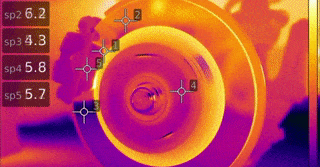Brakes are easily one of the most important parts of your car.
They use pressure to push pads against the rotor,
Slowing rotation and eventually bringing you to a stop. All that friction generates a huge amount of heat.
Also, read:
- ELECTRIC PARKING BRAKE (EPB): COMPONENTS, WORKING PRINCIPLE, AND TYPES
- Fitting new flexible brake hoses
- Difference between Drum Brake and Disc Brake
How much heat? Thanks to Engineering Explained, we can find out.
Jason Fenske of Engineering Explained got the chance to play around with a
FLIR T1K thermal imaging camera that highlights heat sources,
And can measure temperatures depending on colour.
So, he pointed the camera at his Honda S2000’s rear brake setup to see just
How much heat the brakes generate when they’re applied.
Fenske uses five points of reference to capture the data:
The pad, the back of the pad, the calliper, the hub, the rotor before the pad contact point,
And the rotor after the pad contact point.

By spinning the rear wheels and simultaneously pulling the handbrake,
The camera captures temps of almost 300 degrees Fahrenheit (ca. 149 °C).
Also, read – Checking and renewing brake cables
Watch for yourself as Fenske analyzes his car’s brakes;
As they heat up in sweet thermal colours.


5 Comments